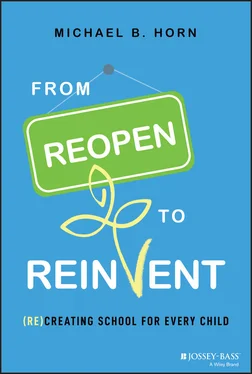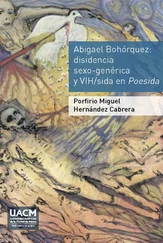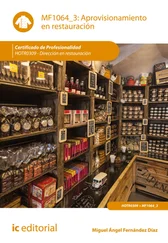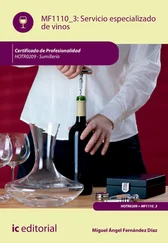Michael B. Horn - From Reopen to Reinvent
Здесь есть возможность читать онлайн «Michael B. Horn - From Reopen to Reinvent» — ознакомительный отрывок электронной книги совершенно бесплатно, а после прочтения отрывка купить полную версию. В некоторых случаях можно слушать аудио, скачать через торрент в формате fb2 и присутствует краткое содержание. Жанр: unrecognised, на английском языке. Описание произведения, (предисловие) а так же отзывы посетителей доступны на портале библиотеки ЛибКат.
- Название:From Reopen to Reinvent
- Автор:
- Жанр:
- Год:неизвестен
- ISBN:нет данных
- Рейтинг книги:4 / 5. Голосов: 1
-
Избранное:Добавить в избранное
- Отзывы:
-
Ваша оценка:
- 80
- 1
- 2
- 3
- 4
- 5
From Reopen to Reinvent: краткое содержание, описание и аннотация
Предлагаем к чтению аннотацию, описание, краткое содержание или предисловие (зависит от того, что написал сам автор книги «From Reopen to Reinvent»). Если вы не нашли необходимую информацию о книге — напишите в комментариях, мы постараемся отыскать её.
From Reopen to Reinvent,
From Reopen to Reinvent
From Reopen to Reinvent
From Reopen to Reinvent — читать онлайн ознакомительный отрывок
Ниже представлен текст книги, разбитый по страницам. Система сохранения места последней прочитанной страницы, позволяет с удобством читать онлайн бесплатно книгу «From Reopen to Reinvent», без необходимости каждый раз заново искать на чём Вы остановились. Поставьте закладку, и сможете в любой момент перейти на страницу, на которой закончили чтение.
Интервал:
Закладка:
Chapter 4delves deeper into why a shift away from the initial framing of learning loss is important and what that should look like within schools. But Gilbert's work suggests a more generalizable, structural way to escape threat rigidity.
After defining something as a threat to muster the required resources, it's then important to shift responsibility to a new independent group that can reframe the threat as an opportunity. In this case, that opportunity is to reimagine the schooling experience. As Gilbert noted, having both a threat and opportunity framing was “hard to maintain in an environment in which operating responsibilities for the [existing organization] predominated.” 5
Another way to think of it is that if there isn't at least one person in the organization whose full-time job is to focus on the opportunity at hand and innovate, then it's no one's job. That's because the day-to-day priorities of the organization will drain energy away from any efforts to create something new and different. In other words, the urgent and immediate tasks in front of someone—even if they aren't important in the long run—will almost always drown out the important but less urgent work of long-term transformation. 6
AUTONOMY
Exactly how independent must a group be for it to be able to reframe a threat as an opportunity, escape the gravitational pull of the existing organization, and innovate successfully? Gilbert's research highlights the benefits of an organization creating a separate entity that has ties back to the parent group for the sharing of certain resources. To calibrate more precisely what this might look like, here is a framework to help guide school leaders.
Every organization has resources, processes, and priorities.
Think of resources as being things like teachers, curriculum, classrooms, technology, books, and so forth.
Processes are ways of working together to address recurrent tasks in a consistent way. They cover everything from how teachers take attendance to how they lesson plan and teach to how the school creates its master schedule and conducts professional development.
Priorities are what an organization must accomplish. 7
Once you understand an organization's resources, processes, and priorities, you can see what it is capable of doing—but also what it is incapable of doing. Any innovation that fits into an organization's resources, processes, and priorities will be readily adopted, but any innovation that doesn't fit neatly into all three will either be twisted and morphed to fit the organization's existing capabilities or ignored and rejected.
What's key when trying to reframe a threat as an opportunity is to create a new organization that has enough freedom to rethink a parent organization's resources, processes, and priorities. This doesn't mean that it will discard all of those things. It may very well borrow things from the parent organization, particularly resources, which are the easiest of the three to share without ruining an independent group's chances of creating something wholly new.
If total transformation is the goal, then the rule of thumb is that a leader must not allow the parent organization the ability to impose its existing resources, processes, and priorities on the autonomous group. The independent team must have the freedom to make the decisions as to what it will and won't take from the parent. 8 The more freedom it has to rethink the parent organization's processes and priorities, the greater the level of innovation possible.
That means that the leader's job is twofold: to make sure the existing entity recognizes its critical role of continuing to execute on its priorities while the new group innovates and to protect the independent team.
THE TOYOTA PRIUS
The story of how Toyota created the Prius, the first commercially successful hybrid car, shows how to bring together a group of individuals with functional expertise in a new team with the flexibility and freedom to rethink the resources and processes for building cars. 9
Amid a flurry of interest in boosting the fuel efficiency of automobiles in the 1990s, Toyota became interested in building a hybrid automobile that would use both gas and electricity. When Toyota developed its Prius hybrid car, however, it could not use its existing functional teams and hierarchical rules of production because the hybrid constituted a completely different architecture.
Toyota had to develop new components that interfaced with each other in novel ways. The internal combustion engine had to share responsibility for powering the car with an electric motor, and each had to hand off that responsibility to the other in different circumstances. The brakes didn't just slow the car; they also needed to generate electricity. This, in turn, completely changed the role the battery played in the system. With the components performing nontraditional functions, the engineers needed to find alternative ways of integrating them into a coherent whole.
To solve these problems, Toyota pulled key people from each department and put them together as a separate team in a completely different location. Although these people brought their functional expertise to the team, their role was not to represent the interests or needs of their respective departments. Rather, their role was to use their expertise to help generate a completely different architecture for the automobile.
This separation and clarity of mission—and sense that they were creating something for the future rather than guarding against a threat of higher fuel standards—gave them the ability to trade the interests of one group against another's: to add costs in one place so they could improve performance or save cost in another; to combine certain components, eliminate others entirely, invent new ones, and so on. This team structure facilitated the creation of an elegant machine.
In contrast, most of Toyota's competitors designed their hybrid cars using their existing departmental structures and hierarchies. Their cars did not perform as well as the Prius, which had superior performance and much higher sales than did the other hybrid offerings.
Toyota kept its team intact for the second-generation Prius to refine the architecture and ensure that it knew how the pieces of the system worked with each other. As its engineers learned clearly how the system worked, they began to codify exactly how to make each component, and how each component had to interface with all other affected components. By doing so, in the next generation the engineers could design the Prius back in a new departmental structure that they could then use for other new automobiles they would create.
SOUTHERN NEW HAMPSHIRE UNIVERSITY
The logic of forming an independent team to solve a pressing problem hasn't just been borne out in industries outside education. Southern New Hampshire University has used it extensively in designing its own responses to what at first were seen as deep threats before it turned them into opportunities.
If you haven't heard of Southern New Hampshire University (SNHU), today it's one of the largest, most successful universities in the world, with over 160,000 students enrolled. But it wasn't always this way. When its current president, Paul LeBlanc, joined SNHU in 2003, it was a threatened institution. Its enrollment was declining. Its finances put the university on the brink of survival.
One interesting asset the University did have was an online offering, but it was small and not growing. With its survival at stake, it wasn't hard to make the case that investing in online learning was critical. But it was LeBlanc's move to separate the online division and create a governance structure different from the one that oversaw the brick-and-mortar campus of the University that proved critical.
Читать дальшеИнтервал:
Закладка:
Похожие книги на «From Reopen to Reinvent»
Представляем Вашему вниманию похожие книги на «From Reopen to Reinvent» списком для выбора. Мы отобрали схожую по названию и смыслу литературу в надежде предоставить читателям больше вариантов отыскать новые, интересные, ещё непрочитанные произведения.
Обсуждение, отзывы о книге «From Reopen to Reinvent» и просто собственные мнения читателей. Оставьте ваши комментарии, напишите, что Вы думаете о произведении, его смысле или главных героях. Укажите что конкретно понравилось, а что нет, и почему Вы так считаете.












